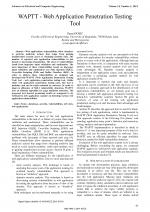| 1/2014 - 15 |
WAPTT - Web Application Penetration Testing ToolDURIC, Z. |
| Extra paper information in |
| Click to see author's profile in |
| Download PDF |
Author keywords
databases, security, vulnerabilities, web sites, web applications
References keywords
application(11), security(10), link(10), applications(9), injection(8), detection(6), analysis(6), vulnerabilities(5), testing(5), static(5)
Blue keywords are present in both the references section and the paper title.
About this article
Date of Publication: 2014-02-28
Volume 14, Issue 1, Year 2014, On page(s): 93 - 102
ISSN: 1582-7445, e-ISSN: 1844-7600
Digital Object Identifier: 10.4316/AECE.2014.01015
Web of Science Accession Number: 000332062300015
SCOPUS ID: 84894630963
Abstract
Web applications vulnerabilities allow attackers to perform malicious actions that range from gaining unauthorized account access to obtaining sensitive data. The number of reported web application vulnerabilities in last decade is increasing dramatically. The most of vulnerabilities result from improper input validation and sanitization. The most important of these vulnerabilities based on improper input validation and sanitization are: SQL injection (SQLI), Cross-Site Scripting (XSS) and Buffer Overflow (BOF). In order to address these vulnerabilities we designed and developed the WAPTT (Web Application Penetration Testing Tool) tool - web application penetration testing tool. Unlike other web application penetration testing tools, this tool is modular, and can be easily extended by end-user. In order to improve efficiency of SQLI vulnerability detection, WAPTT uses an efficient algorithm for page similarity detection. The proposed tool showed promising results as compared to six well-known web application scanners in detecting various web application vulnerabilities. |
| References | | | Cited By |
Web of Science® Times Cited: 5 [View]
View record in Web of Science® [View]
View Related Records® [View]
Updated today
SCOPUS® Times Cited: 10
View record in SCOPUS® [Free preview]
View citations in SCOPUS® [Free preview]
[1] A comparative study of web application security scanners for vulnerability detection, Hasan, Abualese, Thamer, Al-Rousan, i-manager’s Journal on Software Engineering, ISSN 0973-5151, Issue 4, Volume 17, 2023.
Digital Object Identifier: 10.26634/jse.17.4.19813 [CrossRef]
[2] Bridging the Gap: A Survey and Classification of Research-Informed Ethical Hacking Tools, Modesti, Paolo, Golightly, Lewis, Holmes, Louis, Opara, Chidimma, Moscini, Marco, Journal of Cybersecurity and Privacy, ISSN 2624-800X, Issue 3, Volume 4, 2024.
Digital Object Identifier: 10.3390/jcp4030021 [CrossRef]
[3] An Automated Approach to Web Offensive Security, Romano, Simon Pietro, Auricchio, Nicola, Cappuccio, Andrea, Caturano, Francesco, Perrone, Gaetano, SSRN Electronic Journal, ISSN 1556-5068, 2022.
Digital Object Identifier: 10.2139/ssrn.4057341 [CrossRef]
[4] An automated approach to Web Offensive Security, Auricchio, Nicola, Cappuccio, Andrea, Caturano, Francesco, Perrone, Gaetano, Romano, Simon Pietro, Computer Communications, ISSN 0140-3664, Issue , 2022.
Digital Object Identifier: 10.1016/j.comcom.2022.08.018 [CrossRef]
[5] RULE GENERATION BASED ON MODIFIED CUTTLEFISH ALGORITHM FOR INTRUSION DETECTION SYSTEM, EESA, Adel Sabry, SADIQ, Sheren, HASSAN, Masoud, ORMAN, Zeynep, Uludağ University Journal of The Faculty of Engineering, ISSN 2148-4147, 2021.
Digital Object Identifier: 10.17482/uumfd.747078 [CrossRef]
[6] A Systematic Literature Review on the Characteristics and Effectiveness of Web Application Vulnerability Scanners, Alazmi, Suliman, De Leon, Daniel Conte, IEEE Access, ISSN 2169-3536, Issue , 2022.
Digital Object Identifier: 10.1109/ACCESS.2022.3161522 [CrossRef]
[7] SCAnME - scanner comparative analysis and metrics for evaluation, Koman, Jakub, Janiszewski, Marek, International Journal of Information Security, ISSN 1615-5262, Issue 3, Volume 24, 2025.
Digital Object Identifier: 10.1007/s10207-025-01054-8 [CrossRef]
[8] Comparative Analysis of Open-Source Vulnerability Assessment Tools for Campus Area Network, Sharma, Ishu, Pahuja, Vanshika, 2023 International Conference on Emerging Smart Computing and Informatics (ESCI), ISBN 978-1-6654-7524-2, 2023.
Digital Object Identifier: 10.1109/ESCI56872.2023.10100030 [CrossRef]
[9] Customizing OWASP ZAP: A Proven Method for Detecting SQL Injection Vulnerabilities, Alazmi, Suliman, de Leon, Daniel Conte, 2023 IEEE 9th Intl Conference on Big Data Security on Cloud (BigDataSecurity), IEEE Intl Conference on High Performance and Smart Computing, (HPSC) and IEEE Intl Conference on Intelligent Data and Security (IDS), ISBN 979-8-3503-1293-5, 2023.
Digital Object Identifier: 10.1109/BigDataSecurity-HPSC-IDS58521.2023.00028 [CrossRef]
Disclaimer: All information displayed above was retrieved by using remote connections to respective databases. For the best user experience, we update all data by using background processes, and use caches in order to reduce the load on the servers we retrieve the information from. As we have no control on the availability of the database servers and sometimes the Internet connectivity may be affected, we do not guarantee the information is correct or complete. For the most accurate data, please always consult the database sites directly. Some external links require authentication or an institutional subscription.
Web of Science® is a registered trademark of Clarivate Analytics, Scopus® is a registered trademark of Elsevier B.V., other product names, company names, brand names, trademarks and logos are the property of their respective owners.
Faculty of Electrical Engineering and Computer Science
Stefan cel Mare University of Suceava, Romania
All rights reserved: Advances in Electrical and Computer Engineering is a registered trademark of the Stefan cel Mare University of Suceava. No part of this publication may be reproduced, stored in a retrieval system, photocopied, recorded or archived, without the written permission from the Editor. When authors submit their papers for publication, they agree that the copyright for their article be transferred to the Faculty of Electrical Engineering and Computer Science, Stefan cel Mare University of Suceava, Romania, if and only if the articles are accepted for publication. The copyright covers the exclusive rights to reproduce and distribute the article, including reprints and translations.
Permission for other use: The copyright owner's consent does not extend to copying for general distribution, for promotion, for creating new works, or for resale. Specific written permission must be obtained from the Editor for such copying. Direct linking to files hosted on this website is strictly prohibited.
Disclaimer: Whilst every effort is made by the publishers and editorial board to see that no inaccurate or misleading data, opinions or statements appear in this journal, they wish to make it clear that all information and opinions formulated in the articles, as well as linguistic accuracy, are the sole responsibility of the author.



